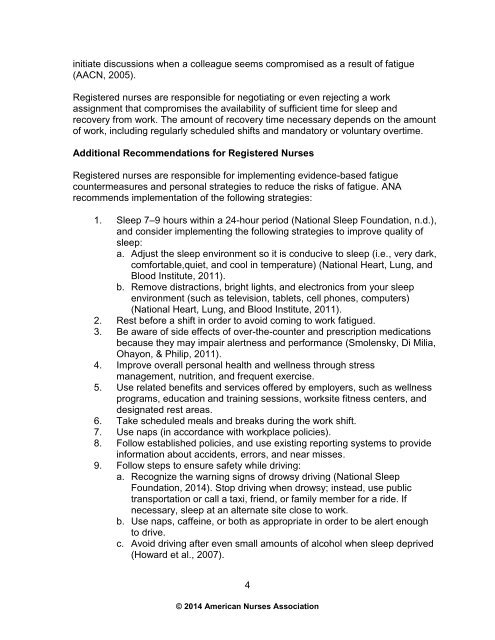Addressing-Nurse-Fatigue-ANA-Position-Statement
Addressing-Nurse-Fatigue-ANA-Position-Statement
Addressing-Nurse-Fatigue-ANA-Position-Statement
- No tags were found...
You also want an ePaper? Increase the reach of your titles
YUMPU automatically turns print PDFs into web optimized ePapers that Google loves.
initiate discussions when a colleague seems compromised as a result of fatigue(AACN, 2005).Registered nurses are responsible for negotiating or even rejecting a workassignment that compromises the availability of sufficient time for sleep andrecovery from work. The amount of recovery time necessary depends on the amountof work, including regularly scheduled shifts and mandatory or voluntary overtime.Additional Recommendations for Registered <strong>Nurse</strong>sRegistered nurses are responsible for implementing evidence-based fatiguecountermeasures and personal strategies to reduce the risks of fatigue. <strong>ANA</strong>recommends implementation of the following strategies:1. Sleep 7–9 hours within a 24-hour period (National Sleep Foundation, n.d.),and consider implementing the following strategies to improve quality ofsleep:a. Adjust the sleep environment so it is conducive to sleep (i.e., very dark,comfortable,quiet, and cool in temperature) (National Heart, Lung, andBlood Institute, 2011).b. Remove distractions, bright lights, and electronics from your sleepenvironment (such as television, tablets, cell phones, computers)(National Heart, Lung, and Blood Institute, 2011).2. Rest before a shift in order to avoid coming to work fatigued.3. Be aware of side effects of over-the-counter and prescription medicationsbecause they may impair alertness and performance (Smolensky, Di Milia,Ohayon, & Philip, 2011).4. Improve overall personal health and wellness through stressmanagement, nutrition, and frequent exercise.5. Use related benefits and services offered by employers, such as wellnessprograms, education and training sessions, worksite fitness centers, anddesignated rest areas.6. Take scheduled meals and breaks during the work shift.7. Use naps (in accordance with workplace policies).8. Follow established policies, and use existing reporting systems to provideinformation about accidents, errors, and near misses.9. Follow steps to ensure safety while driving:a. Recognize the warning signs of drowsy driving (National SleepFoundation, 2014). Stop driving when drowsy; instead, use publictransportation or call a taxi, friend, or family member for a ride. Ifnecessary, sleep at an alternate site close to work.b. Use naps, caffeine, or both as appropriate in order to be alert enoughto drive.c. Avoid driving after even small amounts of alcohol when sleep deprived(Howard et al., 2007).4© 2014 American <strong>Nurse</strong>s Association


